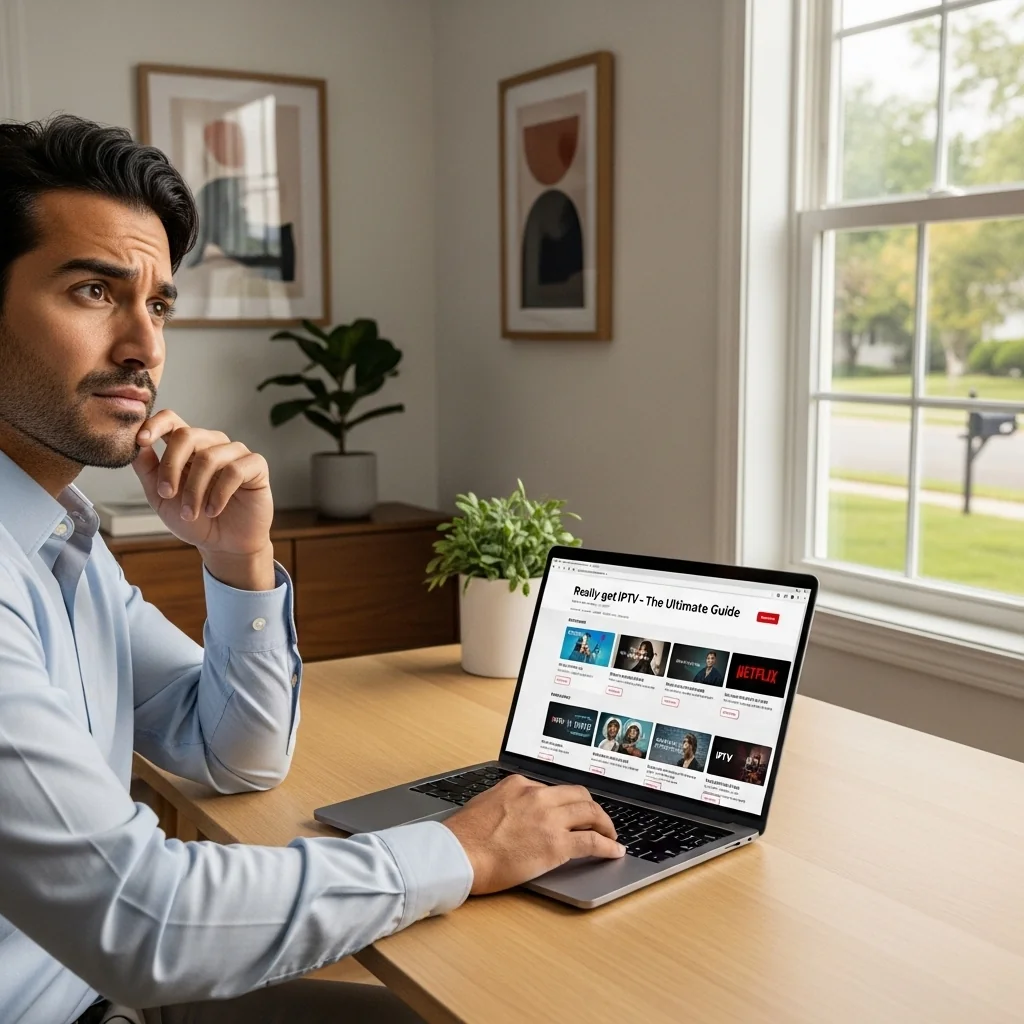Tired of your TV bill looking like a phone book of subscriptions? Discover how a single IPTV service can bundle all your live channels and on-demand shows, just like Netflix, for one low price.
The Streaming Subscription Maze: Are You Paying Too Much?
Let’s be honest, your monthly bank statement probably looks like a who’s who of streaming giants. You started with Netflix, then added Hulu for its next-day TV shows, and Disney+ was a must-have for the kids and Marvel movies. Now you’re paying for Max, Peacock, and Paramount+ just to watch one or two exclusive shows on each. Each subscription feels small on its own, maybe $10 or $15 a month. But when you add them all up, the total can be shocking. Many people are now paying more for streaming than they ever did for their old, bloated cable package, and they don’t even get live sports or news with it.
The Monthly Bill Creep
The cost of individual services has been steadily climbing. What was once a cheap alternative has become a significant monthly expense. It’s a slow drain on your finances that sneaks up on your bank account until you’re paying a premium price for a scattered library of content. This “death by a thousand cuts” approach to billing means you might not even realize how much you’re truly spending. You’re essentially rebuilding the old cable bundle yourself, but with more logins, more apps, and often, a much higher price tag. Here’s a look at how quickly it can add up:
| Streaming Service | Typical Monthly Cost (Ad-Free) | Annual Cost |
|---|---|---|
| Netflix | $15.49 – $22.99 | $185.88 – $275.88 |
| Hulu | $17.99 | $215.88 |
| Disney+ | $13.99 | $167.88 |
| Max | $15.99 – $19.99 | $191.88 – $239.88 |
| Hypothetical Total | $63.46 – $74.96 | $761.52 – $899.52 |
The Illusion of Choice
Having access to everything seems great, but it creates a paradox. You have so many options that you end up paying for massive libraries of content you never touch. You might keep a service active for months just in case you decide to watch that one specific movie. This leads to a few major problems that go beyond just the financial cost:
- Content Overlap: You might be paying for the same movies on three different services.
- Forgotten Subscriptions: It’s easy to sign up for a free trial and forget to cancel, leading to months of wasted money.
- Price Hikes: Services often increase their prices, and you might not notice the extra few dollars being charged each month.
- Bundled Confusion: Services are constantly merging and bundling, making it difficult to track what you actually have and what you’re paying for.
“Subscription Fatigue” is Real: The Hidden Costs of Juggling Services
The problem isn’t just about the money draining from your wallet. “Subscription fatigue” is a genuine feeling of being overwhelmed and exhausted by the sheer number of services you have to manage. It turns entertainment, which should be relaxing, into a frustrating and complicated chore. You spend more time trying to remember which service has the show you want to watch than actually watching it. The dream of on-demand everything has turned into a reality of constantly juggling different logins, user interfaces, and watchlists. It’s a mental burden that slowly chips away at the enjoyment of your downtime.
The Mental Clutter of Multiple Apps
Your smart TV or streaming device home screen is likely a chaotic grid of apps. Finding what you want to watch involves opening Netflix, searching, not finding it, then closing it and opening Hulu, and repeating the process. This digital scavenger hunt is incredibly inefficient and annoying. This constant app-hopping creates a significant amount of mental clutter. You’re not just choosing a show; you’re navigating a maze first. This friction is the opposite of the seamless experience streaming was supposed to provide.
The hidden costs of this clutter include:
- Decision Paralysis: With too many choices spread across too many apps, you often end up scrolling endlessly and watching nothing.
- Fragmented Watch History: Your viewing history is scattered, making it impossible for any single service to give you truly good recommendations.
- Inconsistent User Experience: Every app has a different layout, search function, and control scheme, forcing you to re-learn how to navigate each time.
- Managing Profiles: Keeping track of user profiles for everyone in the family across five or six different services is a headache.
Wasted Time and Frustration
Think about the time you’ve wasted. The 15 minutes spent searching for a movie, the arguments over which service to watch, the frustration when a show leaves a platform right in the middle of your binge-watch. This is valuable time you’ll never get back. The promise of streaming was convenience, but the current model often delivers the opposite. The industry has shifted the burden of content management from the provider (like an old cable company) directly onto you, the consumer. You’ve become your own, unpaid, and highly inefficient cable TV programmer.
The All-in-One Dream: Can You Really Combine IPTV and Netflix?
After dealing with all that frustration, the dream is simple: one app, one search bar, one bill. A single place where you can find your live news, the big game, the latest blockbuster movie, and that binge-worthy series everyone is talking about. This is the core promise of the “IPTV Netflix” concept.
But let’s be clear about what this means. You can’t literally merge your Netflix account into an IPTV service. Instead, the goal is to find an IPTV provider that offers such a massive and well-organized Video on Demand (VOD) library that it makes your separate Netflix subscription redundant.
What “IPTV Netflix” Really Means
The term “IPTV Netflix” is a shorthand for an IPTV service that excels in two key areas. It provides the thousands of live TV channels you expect from IPTV, but it also includes a huge, on-demand library of movies and TV shows that is organized and easy to browse, just like Netflix. It’s about replicating the experience, not a technical integration. You get the best of both worlds in a single subscription:
- Live TV: Access to channels from around the world, including premium sports, 24/7 news, and local stations.
- VOD Movies: A massive collection of films, from new releases to timeless classics, all available to watch instantly.
- VOD Series: Complete seasons of popular TV shows, allowing you to binge-watch without needing a separate streaming service.
- A Unified Interface: All of this content is accessible through one application and often, one electronic program guide (EPG).
The Promise of a Unified Library
Imagine searching for a movie and not having to guess which app it’s on. With a top-tier IPTV service, you search once, and it pulls from its entire VOD catalog. This eliminates the digital scavenger hunt and brings true convenience back to your viewing experience. This unified approach solves the core problems of subscription fatigue. It consolidates your costs into one predictable monthly payment and puts all your entertainment options under one roof. It’s the all-in-one solution that streaming promised but failed to deliver.
What is IPTV and How Does It Offer a Solution?
At its core, IPTV is surprisingly simple. The acronym stands for Internet Protocol Television. All this means is that television content is delivered to you over the internet, the same way websites and videos from YouTube are. It bypasses the need for traditional delivery methods like a satellite dish or a physical coaxial cable. Because it uses the internet, IPTV is incredibly flexible. It isn’t tied to a specific cable box from one company. You can watch it on a huge range of devices you already own, like your smart TV, smartphone, tablet, or a dedicated streaming stick like an Amazon Firestick. This flexibility is the first step in breaking free from the subscription maze.
IPTV 101: Beyond the Acronym
Think of it this way: traditional TV pushes a schedule of shows to you at set times. Streaming services like Netflix pull content from a server whenever you request it. IPTV does both. It can deliver live, scheduled channels in real-time and also provide a massive library of on-demand content you can watch anytime.
This hybrid model is what makes it such a powerful solution. It directly addresses the fragmentation of the modern media landscape by combining live and on-demand content into a single, cohesive service. Key characteristics of IPTV include:
- Massive Channel Selection: Often includes thousands of channels from the US, UK, Canada, and other countries, covering everything from sports to movies.
- Video on Demand (VOD): Includes extensive libraries of movies and full TV series, updated regularly.
- Device Compatibility: Works on a wide array of devices, not just a proprietary cable box.
- Portability: Since it runs over the internet, you can often watch your subscription anywhere with a stable connection.
How IPTV Tackles Subscription Overload
The primary advantage of a good IPTV service is consolidation. Instead of paying five or six different companies, you have one subscription to replace them all. This immediately simplifies your finances and ends the monthly bill creep. Here’s a direct comparison of how IPTV stacks up against the multi-subscription model:
| Feature | Multiple Subscriptions (Netflix, Hulu, etc.) | All-in-One IPTV Service |
|---|---|---|
| Content | Fragmented across many apps | Live TV, VOD Movies, and VOD Series in one app |
| Cost | High cumulative cost ($60-$80+/month) | Low single cost (Typically $10-$25/month) |
| Searching | Requires checking multiple apps | One search function for all content |
| Live TV/Sports | Usually requires a separate, expensive service | Included in the package |
By bringing everything together, IPTV directly solves the problem of subscription fatigue. It reduces complexity, lowers your monthly cost, and saves you the time and frustration of hunting for content.
Finding an IPTV Service with a Netflix-Style VOD Library
Not all IPTV services are created equal, especially when it comes to their on-demand offerings. Many providers focus primarily on live channels, with their VOD library being an afterthought. To truly replace Netflix, you need to find a service that treats its VOD section with care and attention. The goal is to find a provider whose VOD library is vast, well-organized, and regularly updated. It should feel less like a random collection of files and more like a curated, premium streaming service. This is the key to achieving that seamless, all-in-one entertainment hub.
Key Features of a Great VOD Library
When you’re evaluating a potential IPTV provider, pay close attention to the VOD section during your trial period. A high-quality, “Netflix-style” library will have features that make browsing easy and enjoyable. Don’t settle for a chaotic list of titles with no organization. Look for these specific features:
- Clean Categorization: Content should be sorted into logical genres like Action, Comedy, Drama, and Sci-Fi, for both movies and TV series.
- Robust Search Function: A fast and accurate search is crucial for finding specific titles quickly.
- “Recently Added” Section: This shows that the provider is actively updating the library with new content.
- Movie and TV Show Information: Good services will include cover art, plot summaries, ratings (like IMDb), and cast information.
- Full Seasons and Episodes: For TV series, ensure that seasons are complete and episodes are labeled correctly and play in the right order.
Evaluating Potential Providers
Finding the right provider requires a bit of research. Since these services aren’t typically advertised on mainstream platforms, you’ll need to look in communities where users discuss them. Websites like Reddit have dedicated subreddits where you can find honest reviews and recommendations from real users. Before committing to a long-term subscription, create a checklist to evaluate potential services. The best way to do this is by signing up for a short-term plan or a free trial.
- Look for a Free Trial: The best providers are confident in their service and will offer a 24-48 hour free trial. This is your best opportunity to test everything.
- Check VOD Update Frequency: Ask the provider or check community forums to see how often they add new movies and shows.
- Test on Your Primary Device: Make sure the service’s app works smoothly on the device you’ll use most often, whether it’s a Firestick, smart TV, or phone.
- Examine the EPG: For the live TV portion, a clean, accurate, and fast-loading Electronic Program Guide (EPG) is a must-have.
- Customer Support: Test their customer support. Send a simple question and see how quickly and helpfully they respond.
Important Considerations: Legality, Safety, and Quality
Before you dive into the world of IPTV, it’s crucial to go in with your eyes open. This technology exists in a complex space, and it’s important to understand the potential issues regarding legality, personal security, and the quality of the service itself. Being informed is the best way to have a good experience and protect yourself. The simple truth is that the source and licensing of content on many low-cost IPTV services are, at best, unclear. Many of these services operate in a legal gray area by sourcing their streams from various international locations, which may not have the proper distribution rights for your region.
Navigating the Legal Landscape
The legality of using IPTV can depend on the provider and your location. While the technology itself (Internet Protocol Television) is perfectly legal, services that provide access to copyrighted content without proper licensing are not. As a user, the risk is generally low, but it’s not zero.
It is your responsibility to understand the laws in your country. The core issue is that these services are providing access to premium content, like live sports and blockbuster movies, for a fraction of the cost. This is possible because they are not paying the hefty licensing fees that companies like Netflix and ESPN do. To minimize any potential risk, you should focus on:
- Privacy: Never use your primary email address or personal information when signing up.
- Payment: Use anonymous payment methods if available, or a credit card with strong fraud protection. Avoid linking directly to your bank account.
- Discretion: Understand the nature of the service you are using.
Protecting Your Privacy with a VPN
This is the single most important step you can take. Using a high-quality, reputable Virtual Private Network (VPN) is absolutely non-negotiable when using IPTV. A VPN encrypts your internet traffic and masks your IP address, providing a critical layer of privacy and security. A VPN prevents your Internet Service Provider (ISP) from seeing what you are streaming. This is important because some ISPs may throttle (slow down) your connection if they detect high-bandwidth streaming from IPTV sources. A VPN makes your traffic unreadable, ensuring your streaming speeds remain consistent. Here’s why a VPN is essential:
- Anonymity: It hides your online activity from your ISP and other third parties.
- Bypassing Throttling: It prevents your ISP from intentionally slowing down your connection.
- Security: It encrypts your data, protecting you on public Wi-Fi and securing your connection from potential bad actors.
- Geo-Unlocking: While less of a need with IPTV’s vast library, it can help ensure a stable connection by routing your traffic through different servers.
Not All Streams Are Created Equal
Finally, be prepared for variable quality. Unlike Netflix, which controls its entire delivery pipeline, IPTV providers pull streams from many different sources. This means that stream quality and reliability can sometimes be inconsistent. A channel might work perfectly one day and buffer the next.
The best providers invest in stable servers and backup streams to minimize this, but perfection is rare. This is why a free trial is so important. It allows you to test the channels and VOD content you care about most to see if the quality meets your standards before you pay.
Your Action Plan: How to Consolidate Your Subscriptions Today
Ready to stop juggling apps and start saving money? Making the switch to a unified IPTV solution is straightforward if you follow a clear plan. This step-by-step guide will walk you through the process, from evaluating your current spending to canceling the services you no longer need. The key is to be methodical. By taking the time to research and test properly, you can ensure you find a reliable service that fits your needs and finally brings all your entertainment into one convenient place.
Step 1: The Subscription Audit
Before you do anything else, you need to know exactly what you’re spending.
- List All Services: Write down every single streaming service you pay for (Netflix, Hulu, Disney+, Max, Peacock, Paramount+, etc.).
- Note the Cost: Next to each service, write down the exact monthly fee. Don’t forget to check if you’re on an ad-free or bundled plan.
- Calculate the Total: Add up all the monthly costs to get your total monthly streaming spend. You might be surprised by the final number. This figure is your baseline for savings.
Step 2: Research and Find a Provider
Now it’s time to find a potential IPTV service.
- Visit Community Forums: Spend time on sites like Reddit (e.g., the /r/IPTVresellers or /r/IPTVreviews subreddits). Read what actual users are saying about different providers.
- Look for Key Features: Prioritize providers that are praised for their large, well-organized VOD libraries and stable live TV streams.
- Request a Trial: Once you’ve identified 2-3 promising candidates, contact them to ask for a free 24-hour trial. Reputable providers will almost always offer one.
Step 3: Get and Configure Your VPN
Do not skip this step. Before you even start your IPTV trial, get a VPN.
- Choose a Reputable VPN: Select a well-known, paid VPN service that has a strict no-logs policy and fast servers (e.g., NordVPN, ExpressVPN, Surfshark).
- Install the VPN: Install the VPN app on the device you’ll be using for IPTV (e.g., your Amazon Firestick, Android TV box, or computer).
- Connect and Test: Connect to a server and ensure your internet is working correctly. This is now your secure connection for all IPTV activity.
Step 4: Test Drive Before You Commit
Use your free trial period to put the service through its paces.
- Check Your “Must-Have” Content: Search for your favorite TV shows in the VOD library. Test your most-watched live channels during peak hours.
- Evaluate Performance: How quickly do channels load? Is there buffering? Is the VOD interface fast and easy to navigate?
- Test on Multiple Devices: If you plan to watch on your TV and your phone, test the service on both to ensure it works well everywhere.
- Make a Decision: If you’re happy with the performance and content, sign up for a short-term plan (e.g., one month) to start. Avoid long-term commitments until you are 100% confident in the service. Once you are, you can finally start canceling your old subscriptions and enjoy the savings.
Frequently Asked Questions about IPTV Netflix
So, does this IPTV thing really replace Netflix and my other streaming apps?
Think of it more like a giant bundle. Most IPTV services give you access to a huge library of on-demand movies and TV series, similar to what you’d find on Netflix, Hulu, and others. Plus, they usually include live TV channels. So instead of juggling multiple apps, you get a massive collection of content all in one place.
How do I find and watch shows? Is it like the Netflix app?
It’s very similar. You’ll use an app on your smart TV, streaming stick, or phone. Inside the app, there are sections for live TV, movies, and TV shows. You can browse categories or use a search bar to find exactly what you’re looking for, then just click to play.
Is it actually cheaper to get one IPTV plan instead of paying for everything separately?
For most people, yes. Add up what you’re paying for live TV—whether it’s cable or a service like YouTube TV—plus two or three streaming apps. A single IPTV subscription that includes all of that content is almost always going to cost less per month.
What exactly comes with an IPTV service? Is it just on-demand stuff?
You typically get both. The main draw is the combination of thousands of live channels from all over the world—including sports, news, and premium movie channels—and a massive on-demand library of movies and complete TV series that gets updated regularly. It’s designed to be an all-in-one replacement.



